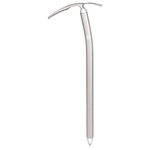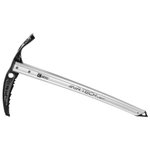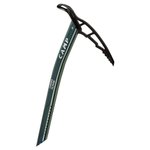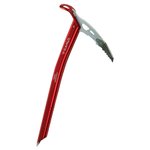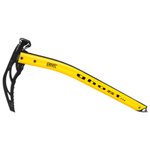Ice axes
Choosing the right ice axe for alpinism
Whether you are looking for an ultralightweight axe, an adze or hammer axe, we have everything you need! An essential piece of climbing and mountaineering equipment to carry on your rucksack for high-altitude mountain expeditions, it makes your life easier on various terrains. There are axes for each activity, be it glacier hikes, mountaineering or ice climbing. Each ice axe features specific characteristics depending on the usage, such as shaft length, shape, style of pick, etc.
Read more Show less

-
Recommended price
£95.61
-13%
£82.56
- 60
- 68


-
Recommended price
£65.25
-20%
£52.11
The Camp Neve is a durable performance ice axe for glacier and mountaineering. The steel pick and straight shaft are bomb proof even when facing the hardest snow.
- 50
- 57
- 65
- 73


-
Recommended price
£104.31
-20%
£82.56
The Black Diamond Raven Pro Ice Axe 50 cm is a model in cast stainless steel with a grooved grip for a reliable hold and a striking head with an ultra-penetrating blade.
- 50
- 55
- 60

-
Recommended price
£126.06
-20%
£99.96
The Petzl Gully Hammer ice axe is very lightweight and strong. It is also adjustable thanks to its Trigrest hand rest.
- 45


-
Recommended price
£86.91
-16%
£72.21
- 45


-
Recommended price
£126.06
-20%
£99.96
| The Petzl Gully Panne ice axe is ultra-compact (45 cm) and weighs only 280 g. Thanks to the Trigrest hand rest it is easily adjustable. This adze version is ideal to dig in snow. |
- 45


-
Recommended price
£130.41
-16%
£108.66
Designed for mountaineering and ski touring, the Blue Ice Akila Adze is a very lightweight and robust technical ice axe that has great penetrating power.
- 49


-
Recommended price
£126.06
-17%
£104.31
The Grivel Air Tech Light Silver is a versatile, lightweight and robust ice axe, ideal for all forms of mountaineering and designed for a reliable, ergonomic grip.
- 48
- 58


-
Recommended price
£82.56
-15%
£69.51
The Camp Corsa Alpine Black ice axe is a lightweight model designed to offer a reliable grip, without snow build-up and with good penetration ability in hard snow and ice.
- 45
- 55
- 65


-
Recommended price
£117.36
-18%
£95.61
The Camp Corsa Nanotech Red mountaineering ice axe is ideal for glacier hiking, ski touring and high-altitude, a technical curved shaped shaft with steel reinforcements.
- 50
- 60


-
Recommended price
£86.91
-15%
£73.86
Petzl's Glacier is an ice axe for glacier trekking. Its steel blade and ergonomic foam ensure optimum grip and anchorage in hard snow and ice.
- 60
- 68
- 75


-
Recommended price
£121.71
-10%
£109.53
The Camp Zenith is a lightweight, high-performing, and versatile ice axe with an ergonomic design, offering exceptional manoeuvrability and precision for various mountaineering situations.
- 50
- 57
- 65


-
Recommended price
£156.51
-13%
£135.63
The Grivel Air Tech Evo Hammer W/G-Slider is a versatile mountaineering tool, combining lightness, strength and balance, with optimum grip thanks to G-Bone technology.
- 48
- 53


-
Recommended price
£154.77
-15%
£131.28
The Grivel Ice Axe Air Tech Evo T Hammer Yellow, hot-forged in Italy, excels in mountaineering and ski-mountaineering thanks to its steel blade and ergonomic G-Bone handle.
- 48
- 53


-
Recommended price
£104.31
-20%
£83.43
The Blue Ice Blackbird ice axe is a very versatile model for mountaineering and glacier routes featuring a steel head and aluminium shaft.
- 49
- 54
- 60


-
Recommended price
£104.31
-20%
£82.56
Lightweight, practical and robust, the Blue Ice Falk is an entry-level technical ice axe that offers high-performance penetration and good grip.
- 45
- 50


-
Recommended price
£110.40
-13%
£95.61
Get ready to climb the peaks with the Grivel Ghost Evo Hammer, an ice axe from Grivel that perfectly combines lightness and robustness. Designed for mountain skiers and mountaineers, this pick is your ideal ally for your most daring adventures. The Ghost Evo Hammer features a curved G-Bone shaft and steel pick for optimum safety. It stands out for its integrated hammer, which adds extra functionality compared to the Ghost Evo.
Grivel Ghost Evo Hammer features:
- Material of construction: steel blade, light alloy
- G-Bone curved handle with steel spike for added safety
- G-Bone curved and tech handle with steel handle spike for added safety
- Ergonomically designed head for good grip and strength
- Available in 45 and 50 cm
- Certification: CE EN 13089, type 1, UIAA 152
- 45
- 50
Loading...
Mountaineering ice axe for high-altitude adventures buyer’s guide:
What are the various parts of a mountaineering axe?
Before buying an ice axe, do you know the different parts? The head is constituted of a pick and an adze or hammer at the end. The pick, commonly in steel, is used to hang on snow or ice. The teeth are bevelled to penetrate the ice while making removal easy. At the opposite end, you can find axes with an adze or a hammer. The adze is mostly used to cut steps, remove snow before putting an ice screw or dig a trench to prepare a deadman anchor. The hammer is used to place pitons or hit on anchors. Historically made of wood, the shaft is made of aluminium nowadays. The shaft can be of varying length depending on the type of activity. For instance, for glacier hiking, a long shaft is preferred, to use the axe as a pole and be able to lean on it. The spike found at the end of some axes improves the grip. Another advantage, it facilitates the penetration of the axe in the snow when used for a deadman anchor.

How to choose the right ice axe (classic mountaineering, technical ice tools)?
Depending on your use, you’ll need a different ice axe. Technical characteristics may vary such as shaft length, head shape, curvature or weight. Some are B certified with type 1 shafts and picks, while some are T certified and much stronger with type 2 shafts and picks.
Choosing a lightweight mountaineering axe for ski touring and steep terrain:
In ski mountaineering and ski touring, most ice axes are used to reach snow-covered peaks. These models are shorter to be less bulky on your backpack, they feature a straight or slightly curved shaft, steel head while being lightweight. You can opt for a lightweight aluminium axe to save weight.
Walking ice axes for glacier routes:
On glacier hikes, ice axes are used to walk on glaciers around snow-covered crevasses. They can be held as a walking stick and used to cut steps. They feature a straight or slightly cured shaft with rounded teeth. The axe length depends on your height. With your arm straight, it should reach your ankle. A glacier hike axe can also be useful to belay someone with a snow anchor or for hauling in case a rope-team member fell in a crevasse.
Versatile mountaineering axes from Petzl, Camp, Blue Ice...:
Some models such as the Sum'Tec from Petzl are very versatile. Not too heavy, not too light, they are B Type certified to offer maximum strength when hauling or for repeated hits on ice. They are slightly curved to improve striking efficiency while being straight enough to be used as walking sticks on shallower gradient. They feature an adjustable hand rest to use them as technical axes in steeper sections.
Technical models:
Ice axes with very curved shafts are designed for ice climbing or technical mountaineering. The curved shape enhances the power when striking. It promotes the penetration of the pick in the ice when ice climbing.
How to choose the size of your ski touring ice axe?
When ski touring, it’s always a good idea to carry an ice axe and crampons in your backpack, as you may encounter sections that are too steep to climb even with ski crampons. At some point, it’s better to take the skis off and switch to alpinism mode. In these situations, the ice axe is essential. There are different models available, and to help you find the right one, we have prepared a guide on how to choose your ski touring ice axe. If you're looking for an ultra-light, slightly curved model with a compact length that is easy to carry on your backpack, you might want to consider the Camp Corsa Nanotech ice axe or the Petzl Ride ice axe. Discover also the models in Black Diamond's range of ice axes or Grivel ice tools.

